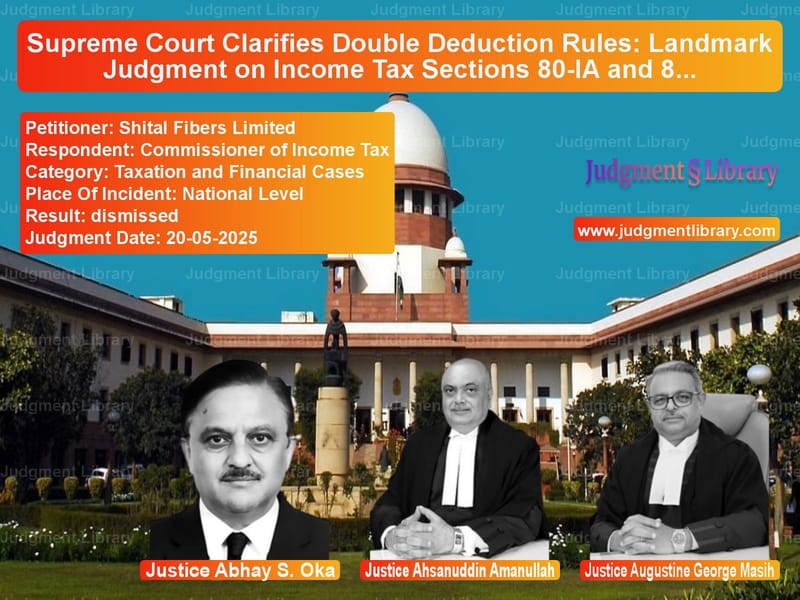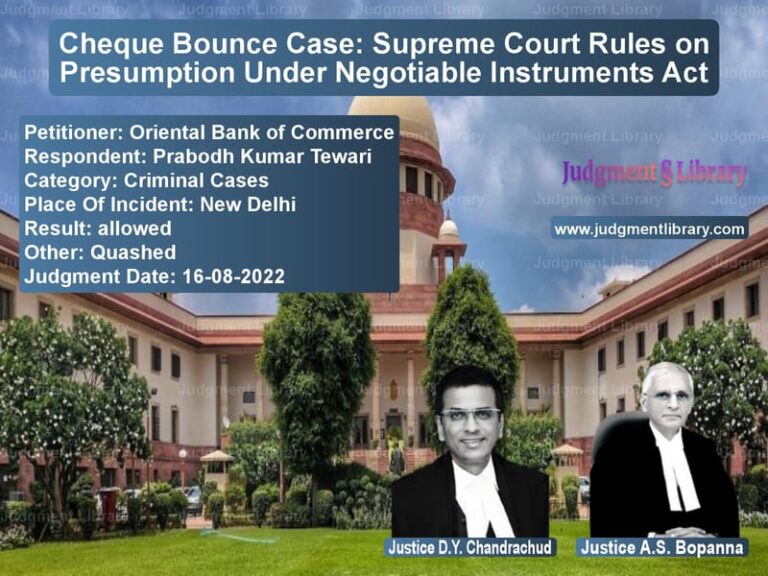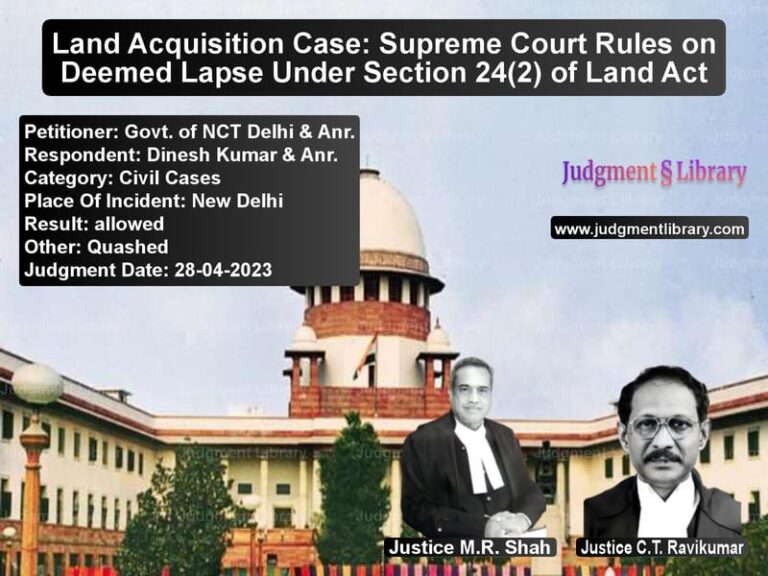Supreme Court Clarifies Double Deduction Rules: Landmark Judgment on Income Tax Sections 80-IA and 80-HHC
In a landmark judgment that brings clarity to one of the most contentious issues in income tax law, the Supreme Court of India has delivered a significant verdict on the interpretation of Section 80-IA(9) of the Income Tax Act, 1961, and its relationship with Section 80-HHC deductions. The case involving Shital Fibers Limited versus the Commissioner of Income Tax has resolved a long-standing dispute about whether taxpayers can claim double deductions for the same profits under different sections of Chapter VI-A of the Income Tax Act.
The Supreme Court bench comprising Justice Abhay S. Oka, Justice Ahsanuddin Amanullah, and Justice Augustine George Masih was hearing a group of appeals and petitions that had been referred to a three-judge bench due to a difference of opinion between two judges in the earlier case of Assistant Commissioner of Income Tax, Bangalore v. Micro Labs Limited. This referral highlighted the complexity and importance of the legal question at hand.
The case originated from Shital Fibers Limited, which had filed its return for the Assessment Year 2002-03 declaring net taxable income of Rs. 46,99,293. The company had claimed deductions under both Section 80-HHC (deduction in respect of profits retained for export business) and Section 80-IA (deduction in respect of profits and gains from industrial undertakings). The return was initially accepted, but reassessment proceedings were initiated later based on the decision of the Income Tax Appellate Tribunal in the case of ACTT v. Rogini Garments.
The appellant’s senior counsel made detailed submissions before the Court, pointing out that “there are 33 different provisions under the heading ‘C’ of Chapter VI-A which includes Section 80-HHC, 80-IA, 80-IAB, 80-IB etc.” He argued that “it is possible for the assessee to claim deductions under each of 33 sections” and that “the legislature has allowed each eligible assessee to claim deductions through 33 provisions under heading ‘C’ of Chapter VI-A.” The counsel emphasized that “the real issue is the extent of deduction allowable separately under Section 80-IA and Section 80-HHC and the extent of deduction allowable through each provision and overall deduction allowable by adding them up.”
The appellant’s counsel further submitted that “the upper limit of profit applies under the heading ‘C’ only in view of Sub-section (9) of Section 80-IA” and supported the view taken by Justice Dipak Misra in the Micro Labs case.
The Revenue, represented by the learned Additional Solicitor General, supported the contrary view taken by Justice Anil R. Dave. He submitted that “the learned Judge rightly held that if an assessee claims any deduction under the provisions of Section 80-IA and/or 80-IB, he cannot claim any deduction to the extent of such profits and gains which had been claimed and allowed under the provisions of Section 80-HHC.” The reason being that “Section 80-HHC is included in heading ‘C’ of Chapter VI-A of the IT Act” and “the profits in respect of which deduction was allowed under Section 80-HHC had also been previously allowed under Section 80-IB.”
The Supreme Court began its analysis by examining the structure of the Income Tax Act, noting that “Under Section 4 of the IT Act, Income Tax is chargeable on the total income of an assessee for previous year.” The Court explained that “Chapter VI-A deals with deductions to be made in computing the total income” and contains five heads, with head ‘C’ dealing with “Deductions in respect of certain incomes.”
The Court focused its analysis on Sub-section (9) of Section 80-IA, which states: “Where any amount of profits and gains of an undertaking or of an enterprise in the case of an assessee is claimed and allowed under this section for any assessment year, deduction to the extent of such profits and gains shall not be allowed under any other provisions of this Chapter under the heading ‘C.—Deductions in respect of certain incomes,’ and shall in no case exceed the profits and gains of such eligible business of undertaking or enterprise, as the case may be.”
The Court provided a clear interpretation of this provision, stating: “Therefore, on plain reading of Sub-section (9) of Section 80-IA, if a deduction of profits and gains under Section 80-IA is claimed and allowed, the deduction to the extent of such profits and gains in any other provision under the heading ‘C’ is not allowed. The deduction to the extent allowed under Section 80-IA cannot be allowed under any other provision under heading ‘C’.”
The Court further elaborated: “Therefore, if deduction to the extent of ‘X’ is claimed and allowed out of gross total income of ‘Y’ under Section 80-IA and the assessee wants to claim deduction under any other provision under the heading ‘C’, though he may be entitled to deduction ‘Y’ under the said provision, he will get deduction under the other provisions to the extent of (Y-X) and in no case total deductions under heading ‘C’ can exceed the profits and gains of such eligible business of undertaking or enterprise.”
The Supreme Court approved the view taken by the Bombay High Court in the case of Associated Capsules (P) Ltd. v. Deputy Commissioner of Income Tax, which had held that “section 80-IA(9) does not affect the computability of deduction under various provisions under heading C of Chapter VI-A, but it affects the allowability of deductions computed under various provisions under heading C of Chapter VI-A, so that the aggregate deduction under section 80-IA and other provisions under heading C of Chapter VI-A do not exceed 100 per cent. of the profits of the business of the assessee.”
The Bombay High Court had provided a practical illustration: “To illustrate, if Rs.100 is the profits of the business of the undertaking, Rs. 30 is the profits allowed as deduction under section 80-IA(1) and the deduction computed as per section 80HHC is Rs. 80, then, in view of section 80-IA(9), the deduction under section 80HHC would be restricted to Rs. 70, so that the aggregate deduction does not exceed the profits of the business.”
The Supreme Court also endorsed the reasoning of Justice Dipak Misra in the Micro Labs case, who had observed: “The first part of sub-section (9) of Section 80-IA refers to the computation of profits and gains of an undertaking or enterprise allowed under Section 80-IA in any assessment year and the amount so calculated shall not be allowed as a deduction under any other provisions of this Chapter. It is in this context that the Bombay High Court has rightly pointed out that there is a difference between allowing a deduction and computation of deduction. The two have separate and distinct meanings.”
Justice Misra had further explained: “Computation of deduction is a stage prior and helps in quantifying the amount, which is eligible for deduction. Sub-section (9) of Section 80-IA does not bar or prohibit the deduction allowed under Section 80-IA from being included in the gross total income, when deduction under Section 80-HHC(3) of the Act is computed.”
The Supreme Court emphasized that “Sub-section (9) of Section 80-IA, on its plain reading, does not provide that when a deduction is allowed under Section 80-IA, while considering the claim for deduction under any of the provision under heading ‘C’, the deduction allowed under Section 80-IA should be deducted from the gross total income. The restriction under sub-section (9) of Section 80-IA is not on computing the total gross income. It restricts deduction under any other provision under heading ‘C’ to the extent of the deduction claimed under Section 80-IA.”
The Court also noted the legislative intent behind Section 80-IA(9), referring to the Central Board of Direct Taxes Circular No. 772 dated December 23, 1998, which stated that “section 80-IA(9) has been introduced with a view to prevent the taxpayers from claiming repeated deductions in respect of the same amount of eligible income and that too in excess of the eligible profits.”
This judgment brings much-needed clarity to the interpretation of Section 80-IA(9) and its interaction with other deduction provisions under Chapter VI-A of the Income Tax Act. The Supreme Court’s ruling establishes that while taxpayers can compute deductions under multiple provisions, the actual allowance of these deductions is subject to the overall limit that the aggregate deductions cannot exceed the total profits of the business.
The decision is significant for businesses engaged in both export activities and eligible industrial undertakings, as it provides a clear framework for claiming deductions under Sections 80-HHC and 80-IA without facing the risk of double deduction for the same profits. The Court’s interpretation balances the legislative intent to prevent abuse of deduction provisions while ensuring that eligible businesses can legitimately claim the benefits intended by Parliament.
The Supreme Court’s judgment represents a comprehensive resolution of a complex legal issue that had divided different High Courts and even judges within the Supreme Court. By providing a clear and practical interpretation of Section 80-IA(9), the Court has brought certainty to an area of tax law that has significant implications for businesses across India.
This landmark decision will serve as an important precedent for future cases involving the interpretation of deduction provisions under Chapter VI-A of the Income Tax Act and demonstrates the Supreme Court’s role in providing clarity and consistency in tax jurisprudence.
Petitioner Name: Shital Fibers Limited.Respondent Name: Commissioner of Income Tax.Judgment By: Justice Abhay S. Oka, Justice Ahsanuddin Amanullah, Justice Augustine George Masih.Place Of Incident: National Level.Judgment Date: 20-05-2025.Result: dismissed.
Don’t miss out on the full details! Download the complete judgment in PDF format below and gain valuable insights instantly!
Download Judgment: shital-fibers-limite-vs-commissioner-of-inco-supreme-court-of-india-judgment-dated-20-05-2025.pdf
Directly Download Judgment: Directly download this Judgment
See all petitions in Income Tax Disputes
See all petitions in Tax Evasion Cases
See all petitions in Tax Refund Disputes
See all petitions in Customs and Excise
See all petitions in Other Cases
See all petitions in Judgment by Abhay S. Oka
See all petitions in Judgment by Ahsanuddin Amanullah
See all petitions in Judgment by Augustine George Masih
See all petitions in dismissed
See all petitions in supreme court of India judgments May 2025
See all petitions in 2025 judgments
See all posts in Taxation and Financial Cases Category
See all allowed petitions in Taxation and Financial Cases Category
See all Dismissed petitions in Taxation and Financial Cases Category
See all partially allowed petitions in Taxation and Financial Cases Category







